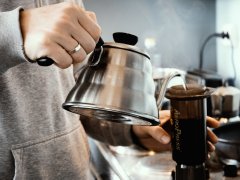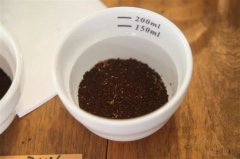Introduction of coffee production equipment and requirements. What kind of instant coffee production equipment are needed?

Professional coffee knowledge exchange more coffee bean information please follow the coffee workshop (Wechat official account cafe_style)
Equipment and facilities
Article 8 the facilities for water supply and drainage, cleaning and disinfection, waste storage, lighting and inspection shall comply with the relevant provisions of the equipment and facilities in the General principles for the examination of Food production permits.
Equipment used for monitoring, control and recording, such as pressure gauges, thermometers, recorders, etc., should be calibrated and maintained regularly.
Article 9 it shall be equipped with production equipment commensurate with the variety and quantity of products produced, including magnetic screening, baking, cooling, stone remover (optional), product pipeline transportation, packaging, X-ray quality detector and other equipment. Nitrogen-filled packaging should be equipped with nitrogen generator or other nitrogen-charging equipment.
The performance, precision and material of the production equipment shall comply with the relevant provisions of the production equipment in the General principles for the examination of Food production license.
Article 10 the distance between the feeding port of raw coffee beans and the ground should be not less than 45 cm, with a special mask. There should be a protective device above the cooling plate of roasted coffee beans to prevent foreign bodies from entering.
Article 11 A changing area shall be set up at the entrance of the production area, and shall be equipped with facilities for changing clothes and shoes (wearing shoe covers) or facilities for disinfection of shoes and boots, and work clothes shall be placed separately from personal clothing and other items. Non-manual hand-washing, hand-drying and disinfection facilities shall be set up at the entrance of the production area to match the number of production and processing personnel.
Article 12 the production area shall be equipped with facilities and equipment for primary and medium-efficiency air purification systems and shall be subject to automatic monitoring.
Article 13 Video surveillance facilities and equipment that can monitor the whole production process shall be installed in the production area.
Article 14 according to the needs of production, appropriate facilities shall be provided for monitoring temperature, humidity and mild humidity in the control room.
The birth history of instant coffee
To talk about the birth history of instant coffee, we have to start with the food giant Nestl é.
Nestl é was founded in the Swiss city of Weiwei. In 1867, German food technician Henri Nestle (also translated as Henry Nestle, Henry Nestle) moved to Switzerland. He named after himself and founded Nestl é, which specializes in the research and development and sales of parenting milk powder.
In the course of Nestl é's development, it has changed its name by merging with other companies and acquired other companies. Of course, in addition to milk powder, Nestl é also sold condensed milk, chocolate and fast food in these processes.
Seeing here, do you feel that although it is a food maker, Nestl é and instant coffee don't seem to match each other?
The reason why Nestl é developed instant coffee began with the excessive coffee production in Brazil in 1930.
As we all know, Brazil is a world-famous coffee producer, and its coffee production has always been high.
In 1930, Brazil ushered in a surge in coffee production, so the supply of Brazilian coffee on the market far exceeded the demand.
Suffering from the inability to preserve coffee beans for a long time, Brazilian farmers who grow coffee have no choice but to pour large amounts of coffee beans into the sea or burn them.
Later, fearing that there would be a famine year that would lead to a poor harvest of coffee and affect domestic earnings, the Brazilian government went to Nestl é and commissioned it to develop espresso that could dissolve immediately and retain the original flavor.
Some friends may wonder why the Brazilian government is looking for Nestl é, a company as far away as Switzerland, to develop instant coffee.
The first is because Nestl é was already a world-famous food company in 1930.
The second is because Nestl é has its own independent technology research and development base-Nestle Technology Co., Ltd. Although Nestle Technology Co., Ltd. is called a company, it is actually a food research laboratory. It is not only large in scale, but also has the most advanced equipment and R & D technology in the world.
In the same year (1930), Nestl é, entrusted by the Brazilian government, welcomed strong foreign aid and an authority in the coffee industry. Max Morgentel, a chemist, joined the Nestl é team and led the team to begin the development of instant coffee.
After eight years, Nestl é finally adopted spray drying technology to develop a kind of coffee powder which can not only dissolve and water, but also preserve the original flavor.
On April 1, 1938, this coffee powder was officially put into production, and the world's first instant coffee was born.
Freeze drying method
In 1965, Nestl é innovated the production technology of instant coffee, and they made more advanced instant coffee by freeze-drying.
The widely used instant coffee production technology, FD freeze-drying (vacuum freeze-drying), is optimized on the basis of Nestle's freeze-drying method.
The manufacturing process of freeze-drying:
The coffee beans are first sent to a silo outside the factory for storage, which can store nearly 560 tons of beans.
The beans are then sent to the oven and baked at a temperature of 200 degrees. The beans in the oven will be constantly stirred to prevent the local temperature from being too high to cause varying degrees of baking or even burning.
After baking, the grinder grinds the coffee beans into a rougher powder.
In a very large coffee machine, the flavor in the coffee powder is squeezed out by hot steam under high pressure. 18000 litres of coffee can be squeezed out every hour. The coffee is then heated and extracted until it is condensed into essence and then sent to the freezer by conveyor belt.
When the temperature of the freezer reaches minus 50 degrees, workers must wear thermal insulation clothes before they can enter. In order to retain the aroma of the coffee, the next step of the extraction of coffee must be frozen into ice, at least 40 degrees below zero. The espresso on the conveyor belt will be frozen into ice during transportation.
At the end of the conveyor belt, the frozen coffee will be crushed. But frozen coffee still contains water, which needs to be removed to make instant coffee, but it loses its aroma if the coffee ice melts. How can you remove the water without letting the coffee ice melt?
The solution is to put the coffee ice cubes in a tray, pile them up, and then stay in a low-pressure pipe for five hours. When heated to 60 degrees in the vacuum of the pipe, the water will sublimate directly from solid to gas under pressure.
When the coffee in the tray comes out of the pipe, it has become a frozen but dried coffee powder. The aroma will be locked up and will not be lost at room temperature, which is the core of freeze-dried coffee production. However, due to the high cost of low-temperature freezing and vacuum heating equipment, some low-quality instant coffee will use spray drying to add flavor.
Then the tray is rotated and the coffee powder is poured into the bag, ready to be packed.
The glass container passes through the conveyor belt and can fill a bottle of coffee in less than a second.
Spray drying technology and freeze drying method
Finally, learn about the application characteristics of spray drying and freeze drying in the production of instant coffee.
Advantages of spray drying:
▅ volume has a positive effect on the solubility in water.
▅, this is a relatively simple and short process.
▅ is cheaper to dry by spray drying than freeze drying, so spray dried products are cheaper than freeze dried products.
The capacity of ▅ spray dryer is much larger than that of freeze dryer.
Disadvantages of spray drying:
▅ products are exposed to high temperature, which damages the performance of the products.
▅ the product is exposed to high temperatures almost immediately and sends its liquid to warmer air.
The liquid dried by ▅ can hardly be heated by its properties and will not significantly change the performance of the product.
The ▅ spray dryer is constructed so that the lubricant can come into contact with the product that needs to be dried.
Due to the high temperature, ▅ will affect the aroma, color and taste of the powder.
Advantages of freeze drying:
Advantages of ▅ freeze-dried products:
▅ volume has a positive effect on the solubility in water.
After rehydration of ▅, the product has the performance of the original product with strength level.
▅ product preparation time is short
The performance of ▅ products remains unchanged because the drying process is carried out at low temperatures.
▅ products are of good quality.
The product structure of ▅ remains intact, which is why the product can absorb liquid again after the drying process.
The quality of ▅ freeze-dried products is very good, mainly because the temperature remains low throughout the process.
Disadvantages of freeze drying:
The cost of the whole process of ▅ is very high and the drying time is very long.
▅, that's why products are 10 times more expensive than spray-dried products.
Freeze drying of ▅ is an energy consuming process.
▅ freeze dryer requires a lot of investment
Of course, no matter how advanced the processing process is, under the current level of technology, part of the aroma of instant coffee will be lost. However, people who are heavily dependent on caffeine need not worry that there is no reduction in caffeine in instant coffee.
END
Important Notice :
前街咖啡 FrontStreet Coffee has moved to new addredd:
FrontStreet Coffee Address: 315,Donghua East Road,GuangZhou
Tel:020 38364473
- Prev

Coffee shop equipment list _ what equipment do you need to open a coffee shop _ essential machines in a coffee shop
Professional coffee knowledge exchange more coffee bean information please follow the coffee workshop (Wechat official account cafe_style) processing category: Italian coffee machine, American coffee machine, special coffee mill, single coffee mill, coffee grounds bucket, merchant dump take-out coffee mill. Coffee utensils: coffee thermometer, electronic scale, 58011 cup cream gun, milk tank, all kinds of coffee cups, wine cup trays, pressure
- Next

Introduction to coffee brewing utensils what are the most commonly used utensils for making coffee?
Professional coffee knowledge exchange more coffee bean information Please follow the coffee workshop (Wechat official account cafe_style) the main tools for coffee extraction include drip coffee siphon pot (Syphon) mocha pot (Moka Pot) Belgian royal coffee pot (Balancing Syphon) French filter pressure pot electric coffee machine hand coffee maker German hair
Related
- Beginners will see the "Coffee pull flower" guide!
- What is the difference between ice blog purified milk and ordinary milk coffee?
- Why is the Philippines the largest producer of crops in Liberia?
- For coffee extraction, should the fine powder be retained?
- How does extracted espresso fill pressed powder? How much strength does it take to press the powder?
- How to make jasmine cold extract coffee? Is the jasmine + latte good?
- Will this little toy really make the coffee taste better? How does Lily Drip affect coffee extraction?
- Will the action of slapping the filter cup also affect coffee extraction?
- What's the difference between powder-to-water ratio and powder-to-liquid ratio?
- What is the Ethiopian local species? What does it have to do with Heirloom native species?

